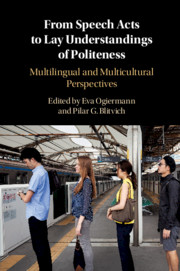Book contents
- From Speech Acts to Lay Understandings of Politeness
- From Speech Acts to Lay Understandings of Politeness
- Copyright page
- Contents
- Figures
- Tables
- Contributors
- Im/politeness between the Analyst and Participant Perspectives: An Overview of the Field
- Part I Concepts and Cultural Norms Underlying Speech Acts
- Part II Concepts and Cultural Norms Underlying Politeness
- Epilogue: Personal Encounters with Politeness Research
- Index
- References
Part II - Concepts and Cultural Norms Underlying Politeness
Published online by Cambridge University Press: 14 June 2019
- From Speech Acts to Lay Understandings of Politeness
- From Speech Acts to Lay Understandings of Politeness
- Copyright page
- Contents
- Figures
- Tables
- Contributors
- Im/politeness between the Analyst and Participant Perspectives: An Overview of the Field
- Part I Concepts and Cultural Norms Underlying Speech Acts
- Part II Concepts and Cultural Norms Underlying Politeness
- Epilogue: Personal Encounters with Politeness Research
- Index
- References
Summary
Culpeper, O’Driscoll and Hardaker’s chapter probes into British people’s understandings of politeness and contrasts them with the understandings of people in North America. Such overarching generalisations, the authors argue, are commonly found in lay persons’ assessments of politeness and thus constitute fertile ground for studies of metapragmatic politeness. Furthermore, the results of a survey of studies focusing on either British culture or North American culture as reified entities indicated a scarcity of emic studies of these cultures in the field of politeness. The authors’ study aims to fill this gap. To that end, they apply corpus linguistic tools to the Oxford English Corpus and subject to scrutiny the lexeme ‘polite’ and the associated clusters of collocates. The results are then triangulated with geolocated Twitter data. Findings partly support both the British and the North American politeness stereotypes, but also show that, contrary to expectations, friendliness and involvement are an important feature of understandings of politeness in both the UK and the USA.
Keywords
- Type
- Chapter
- Information
- From Speech Acts to Lay Understandings of PolitenessMultilingual and Multicultural Perspectives, pp. 175 - 326Publisher: Cambridge University PressPrint publication year: 2019

